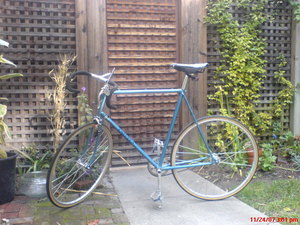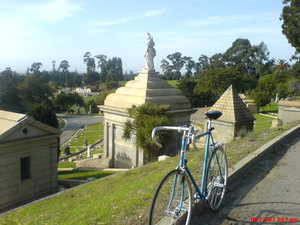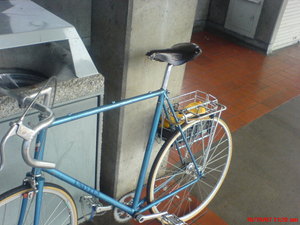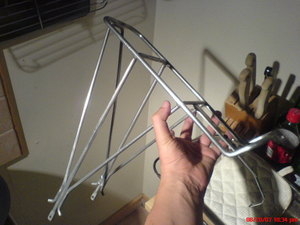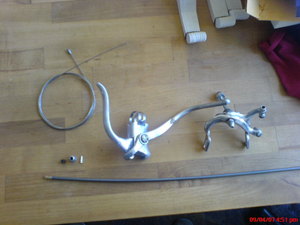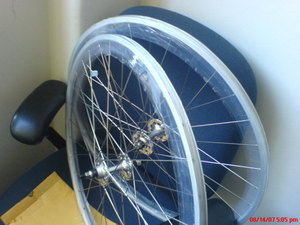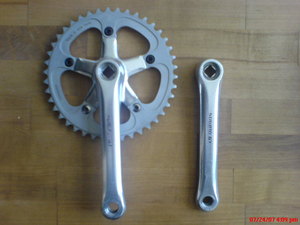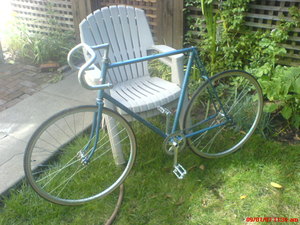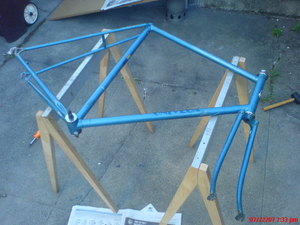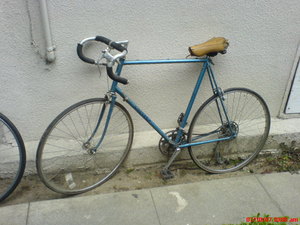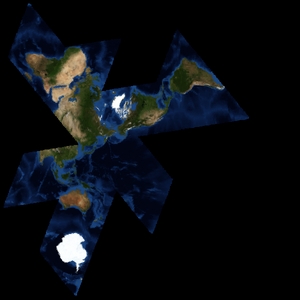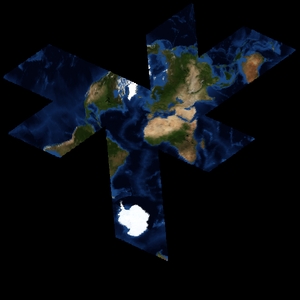tecznotes
Michal Migurski's notebook, listening post, and soapbox. Subscribe to ![]() this blog.
Check out the rest of my site as well.
this blog.
Check out the rest of my site as well.
Nov 24, 2007 11:47pm
univega
Last July, I found a crusty old 80's Univega road bike left out for the trash collectors across the street from our apartment. I'd been considering a project bike of some kind ever since getting and loving the IRO, and this seemed like a low-cost way to noodle with a new bike without breaking the bank. Today, after four months, I bent one of the handlebars back into shape, put on some symbolic tape, and finally called it done:
I've actually been using this thing as my primary bike for a few weeks now, mostly to work and on errands, but also the occasional fun ride.
My original idea was that it would be a utility/beater, so I made sure to get a rack and basket for the back. Doing complete food shopping runs and being able to haul a reasonable amount of stuff is liberating... faster than walking, no time wasted with parking, and loaded with endorphin-producing self-righteousness. I also took the whole thing to Adam at Pacific and asked him to check my work for me... there were a few loose or ungreased bits, and he rebuilt the bottom bracket.
I ended up keeping a lot of the original parts that weren't rusted into lumps. The front brake with giant, goofy lever had to stay.
The original wheels and cranks were garbage. I got these 27" Weinmann rims / Formula hubs from E-bay, and the Sugino cranks from Craigslist.
The first loose build had the cranks on the wrong side. Oops.
Originally I was expecting to keep just the frame. I had also planned to paint it, but I wasn't sure if it was going to be worth keeping. It's turned out to be as good a ride as my track bike, possibly even more comfortable due to the loopy, springy steel frame. I may paint it yet, though I'm certainly not going to drop $200+ to get it done professionally. Ultimately, it'd be nice for it to look like Scott Meyer's Univega on FGG.
Here's how I first found it:
Nov 20, 2007 9:03am
blog all dog-eared pages: science in action
Brian Marick's recent series on Actor-Network Theory (parts I, II, III, and IV) reminded me to dig up Science In Action for a fresh books post. I read this book a little over a year ago, after becoming interested in the philosophy of science through Karl Popper, and further diving has since led me to Paul Feyerabend, Thomas Kuhn, and Tracy Kidder's Soul Of A New Machine.
There are two big ideas I took away from this 20-year-old Bruno Latour book about the workings of science and technology. One is a figure-ground reversal akin to the NRA's famous slogan, "guns don't kill people, people kill people". The second is a description of the social conditions that make science possible. Latour frames his argument by introducing the concept of technoscience, his term for the kind of scientific inquiry that needs people, work, equipment, and funding - national laboratories, cancer research, particle physics, the sort of projects that Russell Davies recently described as thirteen smart guy problems in a post about Malcolm Gladwell.
The figure-ground reversal substitutes the common diffusion model with Latour's translation model. The former explains progress in terms of "ideas moving through society", while the latter places the people who act upon ideas in the foreground. People with desires and beliefs occupy the active role in Latour's world, moving ideas forward if they feel their own plans and agendas to be supported. Latour asserts that the diffusion model provides an inaccurate picture of technoscience, because it fails to account for the conscious agency of the technoscientists themselves. The book is well-stocked with examples of scientific and technological progress explained in terms of the people who linked their fates to a particular theory or invention: General Data's Tom West in Soul Of A New Machine, Rudolf Diesel's engine (and the MAN engineers and mechanics who eventually made it work), and the hypothetical "boss" of a biology laboratory.
Latour also shows how a social division between an inside (within the lab) and an outside (out in the world) make scientific and technical work possible. It is necessary to follow both to make any sense of "where" science happens: the outside supports the inside, allowing it to specialize, channeling funding, equipment, and personnel into the lab by enlisting and guiding the self-interest of universities, governments, and foundations towards to the interests of the lab itself. At the same time, the inside justifies the outside, producing results (process, technology) that fulfills the interests of those outside. On the boundary between the inside and outside sits the boss-figure, the scientist or engineer who motivates the lab and fights for its continued survival. "Firefighter up, cheerleader down" as my friend and first boss Darren used to say.
Science In Action has been quite a ride, and I've tried to apply its observations to my own company in a number of ways. For one, it has been instructive to think in terms of inside/outside with our activities, switching between "doing the work" and "talking about the work", having people specialize in one but not the other, and recognizing the importance of aligning the broader world's interests with our own. The time this becomes unusually rewarding are probably more frequent than we rightfully deserve: months of digging deep into nothing by maps, followed by a string of projects focused on images or time. It means we can juggle a lot of balls in the air without everyone fragmenting off into their own private corners. I've also recently sat in on the standards process behind OAuth, and have tried to judge it by Latour's translation model to see where good ideas were being moved about through conscious alignment of many groups' self-interests. I found this quite instructive.
Latour also has a way of describing the idea of a black box that resonates deeply. When I think back to my first visits to San Francisco (upper Haight when in High School, Bahia Cabana, the Mission, and downtown early in college), the city had not yet solidified in my mind, and I encountered each neighborhood on its own terms without a clear understand of how they fit together. The process by which novelty is transformed into familiarity and later background marks the passage of time. Sometimes it'd be nice to unlearn things at will.
Pages 91-92, on reification:
All biologists now take 'protein' for an object; they do not remember the time, in the 1920s, when protein was a whitish stuff that was separated by a new ultracentrifuge in Svedberg's laboratory. At the time protein was nothing but the action of differentiating cell contents by a centrifuge. Routine use however transforms the naming of an actant after what it does into a common name. This process is not mysterious or special to science. It is the same with the can opener we routinely use in our kitchen. We consider the opener and the skill to handle it as one black box which means that it is unproblematic and does not require planning and attention. We forget the many trials we had to go through (blood, scars, spilled beans and ravioli, shouting parent) before we handled it properly, anticipated the weight of the can, the reactions of the opener, the resistance of the tin.
Page 107, on phasing:
If the notion of discrete phases is useless, so, too, is that of trajectory. It does not describe anything since it is again one of the problems to be solved. Diesel indeed claimed that there was one trajectory which links his seminal patent to real engines. This is the only way for his patents to be 'seminal'. But this was disputed by hundreds of engineers claiming that the engine's ancestry was different. Anyway, if Diesel was so sure of his offspring, then why not call it a Carnot engine since it is from Carnot that he took the original idea? But since the original patent never worked, why not call it a MAN engine, or, a constant pressure air injection engine? We see that talking in phases in a trajectory is like taking slices from a pate made from hundreds of morsels of meat. Although it might be palatable, it has no relation whatsoever to the natural joints of the animal.
Page 137, on cameras and black boxes:
Let us remember Eastman's Kodak camera. It was simpler to operate than anything else before. 'Push the button, we'll do the rest,' they said. But they had to do the rest, and that was quite a lot. The simplification of the camera that made it possible to interest everyone in its dissemination in millions of copies had to be obtained by the extension and complication of Eastman's commercial network. When you push the button you do not see the salesmen and the machines that make long strips of celluloid films and the troubleshooters that make the coating stick properly at last; you do not see them, but they have to be there none the less. If they are not, you push the button and nothing happens. ... If we have understood this, then we may draw the conclusions from the two first parts of this chapter: the black box moves in space and becomes durable in time only through the actions of many people; if there is no one to take it up, it stops and falls apart however many people may have taken it up for however long before. But the type, number, and qualifications of the people in the chain will be modified: inventors like Diesel or Eastman, engineers, mechanics, salesmen, and maybe 'ignorant customers' in the end. To sum up, there are always people moving the objects along but they are not the same people all along.
Page 141, on diffusion vs. translation and why society is a fiction:
Among all the features that differ in the two models, one is especially important, that is society. In the diffusion model society is made up of groups which have interests; these groups resist, accept, or ignore both facts and machines, which have their own inertia. In consequence we have science and technics on the one hand, and a society on the other. In the translation model, however, no such distinction exists since there are only heterogeneous chains of associations that, from time to time, create obligatory passage points. Let us go further: belief in the existence of a society separated from technoscience is an outcome of the diffusion model. Once facts and machines have been endowed with their own inertia, and once the collective action of human and non-human actors tied together has been forgotten or pushed aside, then you have to make up a society to explain why facts and machines do not spread.
Page 152, on specialization and isolation:
...an isolated specialist is a contradiction in terms. Either you are isolated and very quickly stop being a specialist, or you remain a specialist but this means you are not isolated. Other, who are as specialized as you, are trying out your material so fiercely that they may push the proof race to a point where are of your resources are barely enough to win the encounter. A specialist is a counter-specialist in the same way as a technical article is a counter-articles (Chapter 1) or a laboratory is a counter-laboratory (Chapter 2).
Page 155, defining outside and inside:
This case shows how important it is to decide who are the people to study. Depending on which scientist is followed, completely different pictures of technoscience will emerge. Simply shadowing West or the boss will offer a businessman's view of science (mixture of politics, negotiation of contracts, public relations); shadowing the microkids or the collaborators will provide the classic view of hard-working white-coated scientists wrapped up in their experiments. In the first case we would be constantly moving outside the laboratory; in the second, we would stay deep inside the laboratory. Who is really doing research? Where is the research really done?
Page 156, more on inside and outside:
The first lesson to be drawn from these examples is rather innocuous: technoscience has an inside because it has an outside. There is a positive feedback loop in this innocuous definition: the bigger, the harder, the purer science is inside, the further outside other scientists have to go. It is because of this feedback that, if you get inside a laboratory, you see no public relations, no politics, no ethical problems, no class struggle, no lawyers; you see science isolated from society. But this isolation exists only in so far as other scientists are constantly busy recruiting investors, interesting and convincing people.
Pages 231-232, on modeling space and time:
Professor Bijker takes a metre-long plaster model of a new dam, fixes it into place and launches a first round of tides shortened to twelve minutes; then he takes it out, tries another one and continues. Sure enough, another 'Copernican revolution' has taken place. There are not that many ways to master a situation. Either you dominate it physically; or you draw on your side a great many allies; or else, you try to be there before anybody else. How can this be done? Simply by reversing the flow of time. Professor Bijker and his colleagues dominate the problem, master it more easily than the port officials who are out there in the rain and are much smaller than the landscape. Whatever may happen in the full-scall space-time, the engineers will have already seen it. They will also have become slowly acquainted with all the possibilities, rehearsing each scenario at leisure, capitalising on paper possible outcomes, which gives them years of experience more than others. The order of time and space has been completely reshuffled. Do they talk with more authority and more certainty than the workmen building the real dam there? Well, of course, since they have already made all possible blunders and mistakes, safely inside the wooden hall in Delft, consuming only plaster and a few salaries along the way, inadvertently flooding not millions of hard-working Dutch but dozens of metres of concrete floor.
Pages 248-249, where it all breaks down:
When the architects, urbanists and energeticians in charge of the Frangocastello solar village project in Crete had finished their calculations in early 1980 they had in their office, in Athens, a complete paper scale model of the village. They knew everything available about Crete: solar energy, weather patterns, local demography, water resources, economic trends, concrete structures and agriculture in greenhouses. They had rehearsed and discussed every possible configuration with the best engineers in the world and had triggered the enthusiasm of many European, American, and Greek development banks by settling on an optimal and original prototype. Like Cape Canaveral engineers the had simply to go 'out there' and apply their calculations, proving once again the quasi-supernatural power of scientists. When they sent their engineers from Athens to Frangocastello to start expropriating property and smoothing out the little details, they met with a totally unexpected 'outside'. Not only were the inhabitants not ready to abandon their lands in exchange for houses in the new village, but they were ready to fight with their rifles against what they took as a new American atomic military base camouflaged under a solar energy village. The application of the theory became harder every day as the mobilisation of opposition grew in strength, enrolling the pope and the Socialist Party. It soon became obvious that, since the army could not be sent to force Cretans to occupy willingly the future prototype, a negotiation had to start between the inside and the outside. But how could they strike a compromise between a brand new solar village and a few hundred shepherds who simply wanted three kilometres of asphalted road and a gas station? The compromise was to abandon the solar village altogether. All the planning of the energeticians was routed back inside the network and limited to a paper scale model, another one of the many projects engineers have in their drawers. The 'out-thereness' had given a fatal blow to this example of science.
Page 249, networks and a conclusion by way of prediction:
So how is it that in some cases science's predictions are fulfilled and in some other cases pitifully fail? The rule of method to apply here is rather straightforward: every time you hear about a successful application of science, look for the progressive extension of a network. Every time you hear about a failure of science, look for what part of which network has been punctured. I bet you will always find it.
Nov 11, 2007 7:54am
more like faumaxion
Earlier this week I posted a bungled attempt at implementing Buckminster Fuller's Dymaxion World Map. Owing to a rainy Saturday, that first pass at understanding the projection has matured into something a bit more stable and applicable.
I've been working from Robert Gray's C Implementation of the world map, but after getting it working I ended up discarding it. There are a few limitations with Fuller's projection math and Gray's implementation. I decided to stick with the icosahedron layout on the original map, but switched to the gnomonic projection, similar to Fuller's but blessed with an inverse:
... in computer applications where you "click" on a position on the flat map to get an (x,y) coordinate pair, and you have to convert this to the corresponding (longitude, latitude) coordinate pair, you would have to "loop through" Fuller's projection method several times to get an approximate answer whereas in the Gnomonic case, there is no looping, you have an exact "inverse" equation. -Robert Gray
The gnomonic does pretty much exactly the right thing, in much less space. In effect, each triangular face of the main icosahedron becomes a little projection of its own, accurate at the center and a little less-so at the edges. The general idea is that maps can be arranged about any point on the earth's surface without computationally expensive image reprojection, and with a minimum of surface tearing near the center.
Gray's example code also has just one unfolding of the map hard-coded, making it difficult to create flexible arrangements of land masses for specific needs. It's more interesting to have a version that supports a variety of layouts, like these views centered on various parts of the Atlantic:
The surface coloration I use is from NASA's Blue Marble satellite image set, something I've written about before. I'm not yet sure how to go about making the faumaxion code public, but I imagine that it may find its way into Modest Maps some time in the future.
Nov 6, 2007 8:41pm
not necessarily dymaxion
This is the first output of a raw Python port of the Fuller Dymaxion projection.
It's not quite the thing, but cool nonetheless:

